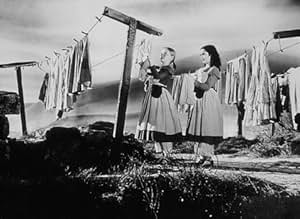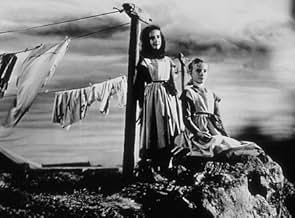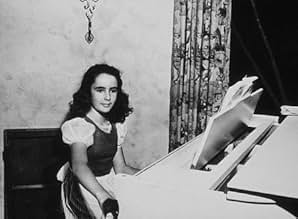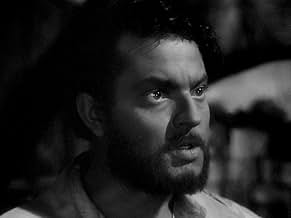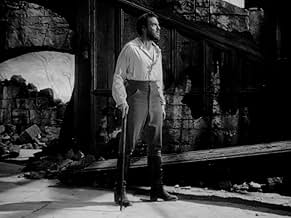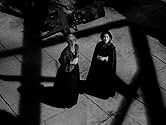Après une enfance difficile, l'orpheline Jane Eyre est engagée par Edward Rochester, le seigneur maussade d'un mystérieux manoir, pour s'occuper de sa jeune fille.Après une enfance difficile, l'orpheline Jane Eyre est engagée par Edward Rochester, le seigneur maussade d'un mystérieux manoir, pour s'occuper de sa jeune fille.Après une enfance difficile, l'orpheline Jane Eyre est engagée par Edward Rochester, le seigneur maussade d'un mystérieux manoir, pour s'occuper de sa jeune fille.
- Prix
- 3 victoires au total
- Mason
- (uncredited)
- Guard
- (uncredited)
- Bookie
- (uncredited)
- Townsman
- (uncredited)
- Woman at Party
- (uncredited)
- Proprietor
- (uncredited)
Avis en vedette
Under Robert Stevenson's direction Fontaine/Welles seem to capture the essence of two abused outsiders resisting their attraction for one another, trying to adhere to convention. A strong supporting cast. There are brief though memorable appearances by Agnes Moorehead, Elizabeth Taylor and Peggy Ann Garner as "young" Jane.
George Barnes' camera captures appropriately stark images of Ross Dowd and Thomas Little's sets. Charlotte Bronte's grim novel is well suited to the excellent B/W, cinematography: a memorable scene early in the film has young Jane being punished by being forced to stand on a stool that is nearly in the center of a fan of shadows cast by the stair railing, It is almost reminiscent of expressionist German films of the Weimar years.
The film manages to entertain as well as inform. Purists may object to the last 3 lines of the film which hint at a slightly happier denouement than the book offered. In spite of that, Jane Eyre is still a nearly flawless film.
Yet when it's not reminding us that it's at heart a version of something else, it's a very good film, falling not too far short of David Lean's "Oliver Twist" - which it resembles. Both films were shot almost entirely in the studio, yet don't feel studio-bound; they feel rather as though the directors had managed to find unusually claustrophobic out-of-door (or, in Lean's case, urban) locations. In both films a portion of every frame is consumed by impenetrable shadow. (Yet "Eyre" is detailed, and makes the best possible use of every frame.) Both films take place around in a callous England of the 1920s. (I got the impression that if Brönte's characters had for some reason gone to London they would have encountered Dickens's, although this impression was destroyed when the rich Londoners visit Rochester's castle.) Both films manage to be sentimental in an agreeable way. Both have excellent musical scores. In fact, this may be Herrmann's best score of the 1940s, certainly better than the one he wrote for "Citizen Kane", which is seems better than it is because the film as a whole is a masterpiece.
If you can, make sure you see a print with a pristine soundtrack. Orson Welles isn't always easy to understand.
After a harsh and eye opening childhood, orphan Jane Eyre gains employment at Thornfield Hall as governess to the young ward of Edward Rochester. A Difference in class and life outlook, Jane and Rochester are by definition polar opposites, but a bond exists, a bond that surely can't conquer the mysteries of Rochester the man, and the secret of his estate - can it?
Stevenson's version of the often filmed Jane Eyre has been pored over numerous times before, the constant question that arises is that of just how much input and work did Orson Welles have in the production? Knowing what we now know of Welles' 40s output, Jane Eyre undeniably has the Wellesian stamp all over it, with Fontaine herself quoted as saying the big man was often found behind the camera. This is not to decry Stevenson in any way, he himself would carve out a good career in directing further down the line, but this take on Brontë's famous novel shines because of Welles' presence in front and behind the camera.
With that comes one of only two quibbles with the film as a whole, namely it's Welles' portrayal of Rochester that dominates the film, and not that of Fontaine's Eyre. Which is quite staggering considering he doesn't enter the fray until 34 minutes into ty epic. The other problem, naturally, is that with a running time of just over an hour and thirty five minutes, it was never going to be a detailed adaptation of the novel. However, what exists is still an excellent mounted production, a film pulsing with aggressive atmospherics and simmering emotional passions.
It has been argued that the opposing acting styles of Fontaine and Welles are a distraction, I don't see it that way at all, as one of classic cinemas greatest voices emotionally spars with one of its most beautiful faces, this is monochrome gold dust. In mind of the difference of characters as written on the page, it actually comes off as inspired casting. With the production that surrounds them perfectly in keeping with the characters' state of mind.
The look is assuredly what would become known as film noir, with George Barnes' (Rebecca/Spellbound/Force of Evil) vivid black and white photography dovetailing splendidly with the matte paintings and Gothic set designs. It still amazes me to this day that this film was entirely produced on stage 2 at 20th Century Fox. So many images burn into the memory. From the shards of shadows that accompany young Jane as she stands on the punishment stool at Lowood Institution, put there by the despotic Henry Brocklehurst (a menacing Henry Daniell), to each chiaroscuro lit composition of Rochester in and around the oppressive like family home, the film has visual moodiness in abundance.
Herrmann's (The Devil and Daniel Webster/Citizen Kane) score is crucially in tune as well. Orchestral swirls to portray Jane's longing are counter pointed by the menacing down beats that attack the viewer for Rochester's bluster. Away from the two leads it's young Peggy Ann Garner who delivers the most telling performance. She gives the child version of Jane a sorrowful edge that sets the tone of the film, her early scenes with an uncredited Elizabeth Taylor (beautiful and effectively correct in vocals) are a lesson in child acting. The rest of the cast is filled out with admirable performances from Margaret O'Brien (Meet Me in St. Louis), John Sutton (Captain from Castille), Sara Allgood (The Lodger) and Agnes Moorehead (The Magnificent Ambersons).
This may not be a definitive Jane Eyre adaptation, and the compromised ending does knock it down a point, but all told it's still a top piece of classic cinema. 9/10
This version was shot when black and white film-making was at it's best, and Fox was known as the best at noir/Gothic, with velvety blacks, and really crisp lighting and shading. One thing that helps this film be better is that it has the best script (by Huxley, Stevenson and Houseman). The script transitions well, and really captures the major emotional elements of the story. This version also has the best child Jane (Peggy Ann Gardner). I agree with many that Zelah Clarke (Jane in the 1983 miniseries) is probably the definitive adult Jane, but Joan Fontaine is equally fine, and many people will simply not sit through the slow miniseries. Joan Fontaine was not a glossy beauty, and was usually cast as "plain" despite her natural loveliness. She has a real sense of refined restraint that seems very natural, and her strength is not so much in knowing she is strong, but overcoming her weakness. That is a very important mental/emotional component for getting Jane right.
Orson Welles is beefy and sexy, and plays every note of Rochester perfectly. If he is a bit too young for the role, that is the only flaw. While I feel that Cirian Hinds (the 1997 film version) is the best Rochester, Welles performance equals him. Once again, the striking dark haired beauty Blanche was cast with a platinum blonde, she is undeniably and great and striking beauty, and is the best of the Blanche easy to see why men like her, and why women don't. Little Margaret O'Brien, who I usually find cloying and hammy is, of course, the perfect Adele, so we have the best Adele, too! She is absolutely convincingly the daughter of a diva, a dancer and coquette, and her "look at me" peskiness is just right for Adele.
The supporting roles, just simply nail the characters as described in the book, Broklehurst, Agnes Morehead as the Aunt, Mrs. Fairfax, and young Elizabeth Taylor as young Jane's friend all add up to make this a masterpiece. Having Bernard Herrmann do the score doesn't hurt a bit, either. (Film buffs will find it of interest that some of the exact themes and sound cues used in this film were also used again in Hitchcock's NORTH BY NORTHWEST.) See the 1934 version for a laugh and film history. See the 1983 miniseries to see the truest rendition of the book. See the 1997 version for breathtaking color, scenery and Cirian Hinds' Rochester. See this to be fully satisfied. This is simply an exquisite film film-making at its best in every respect; and while not as letter-perfectly definitive as the 1983 miniseries, I feel it is overall the best, truest version of JANE EYRE.
Le saviez-vous
- AnecdotesAfter securing the screen rights, David O. Selznick originally approached Orson Welles to play the role of Rochester opposite Selznick contractee Joan Fontaine. He got Aldous Huxley, John Houseman, and Robert Stevenson involved. Ultimately though, he sold the package to Darryl F. Zanuck and Twentieth Century Fox.
- GaffesThe text of "Jane Eyre, Chapter 1" that appears on screen does not correspond to the text of Bronte's novel. Chapter 1 actually opens, "There was no possibility of taking a walk that day. We had been wandering, indeed, in the leafless shrubbery an hour in the morning; but since dinner (Mrs. Reed, when there was no company, dined early) the cold winter wind had brought with it clouds so sombre, and a rain so penetrating, that further out-door exercise was now out of the question."
- Citations
[first lines]
Jane Eyre: [narrating] My name is Jane Eyre... I was born in 1820, a harsh time of change in England. Money and position seemed all that mattered. Charity was a cold and disagreeable word. Religion too often wore a mask of bigotry and cruelty. There was no proper place for the poor or the unfortunate. I had no father or mother, brother or sister. As a child I lived with my aunt, Mrs. Reed of Gateshead Hall. I do not remember that she ever spoke one kind word to me.
- Autres versionsThere is an Italian edition of this film on DVD, distributed by DNA srl, "JANE EYRE (1943) + LETTER FROM AN UNKNOWN WOMAN (1948)" (2 Films on a single DVD), re-edited with the contribution of film historian Riccardo Cusin. This version is also available for streaming on some platforms.
- ConnexionsFeatured in AFI Life Achievement Award: A Tribute to Orson Welles (1975)
Meilleurs choix
- How long is Jane Eyre?Propulsé par Alexa
- What is 'Jane Eyre' about?
- Is 'Jane Eyre' based on a book?
- Is this the first film adaptation of the novel?
Détails
- Date de sortie
- Pays d’origine
- Site officiel
- Langue
- Aussi connu sous le nom de
- Alma rebelde
- Lieux de tournage
- société de production
- Consultez plus de crédits d'entreprise sur IMDbPro
Box-office
- Budget
- 1 705 000 $ US (estimation)
- Durée1 heure 37 minutes
- Couleur
- Rapport de forme
- 1.37 : 1
Contribuer à cette page



